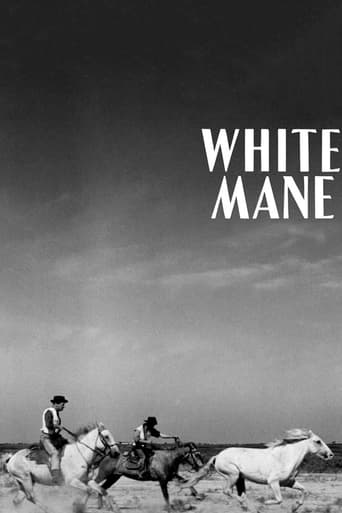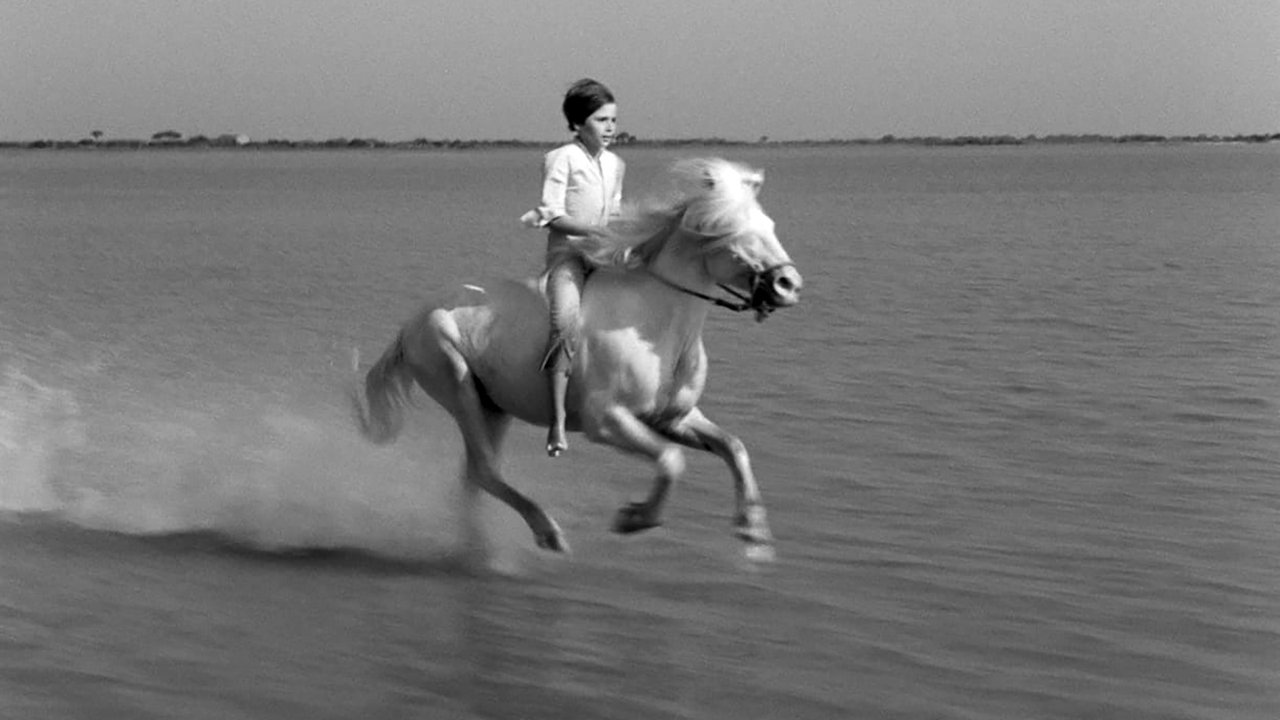jacksflicks
Here is a child-and-horse story that goes beyond Hollywood clichés. It's idyllic and untamed, with an undertone of menace.The somewhat artless execution is redeemed by the sublime theme and photography. And the ending blew me away.Then, there's the wonderful acting of the principles. The boy is beautiful and earnest, his little family achingly sweet. Notice the little sister. At very young ages they tend to be undisciplined. But this tot is fully into her part, doubtless thanks to director Albert Lamorisse, who later directed his masterpiece, The Red Balloon. Of course the old grandpa is completely natural. The herders are less convincing as actors, though spectacular as horsemen.The poignancy of the story reminds me of The Little Prince (book), also by a Frenchman. The French are very good at childhood themes. See Forbidden Games, War of the Buttons, the 400 Blows, the aforesaid Red Balloon, and Zero for Conduct, the masterpiece by Jean Vigo, whose eponymous prize White Mane won, as well as Cannes.
bts1984
Apparently there are two versions of this shorty: a 47-minute version and a 38-minute version. But I can only find the one with 38 minutes, where is the other one, if it really exists? Plus, if there really is a longer version, I wonder what it contains that the shorter one doesn't.There is a lot to like about this short, especially for those who love horses. Without being a huge fan of horses, I like them and admire their formidable strength, imponence and pride.This small film is very well-made and filmed. The black and white suits it so nicely. The rural scenario is gorgeous, thanks to the natural beauty of Camargue.This is the story of Crin Blanc, a white stallion that is wild, fearless, carefree, runs like the wind, despises humans, refuses to get caught and doesn't let anyone ride him. In other words, the lead horse is wild like all the other horses seen in it, however it is the leader of the herd. It is a nice-looking stallion but behind its beauty and elegance lies a fearsome leader, a proud and suspicious horse which doesn't like and trust in people and doesn't hesitate to look down on them with arrogance, a stubborn and determined horse which, more than never letting itself get caught, doesn't let itself get caught by nothing in this world. That is, until the day he meets a brave kid. The task is anything but easy, yet the boy quickly wins the heart and confidence of the majestic stallion, after some initial resistance and despite the strength of its wild instincts. Though very different from each other, Crin Blanc, the boy and the ranchers have one thing in common: their determination. My description might sound a bit of a criticism, but it's not. Good thing it is like that, otherwise it'd become another victim of human cruelty. While we never know why those four ranchers wanted to capture it for, we can assume that they'd make money out of it somehow, possibly in inhuman ways.Everything feels authentic in this short. For good and for bad. As a matter fact, certain scenes are pretty violent and even creepy.As with 'Le Ballon Rouge' (itself by Albert Lamorisse either), this one is silent most of the time but not completely wordless because some lines are delivered. This one's even got a little more dialog than 'Le Ballon Rouge'. Still, there aren't many dialogs, which means that to understand it without subtitles is not much of a problem, although it's always better having subtitles in order to understand it better.The ending is something of a mystery: do the kid and the horse die? At least that's what strongly implied in the narrator's words: «Crin Blanc took Folco to a land where horses and children can be friends forever.» Alain Emery is superb as the boy and his face and eyes are so expressive that they speak more than the few words and sounds he ever delivers.This little movie is aimed at those who likes quality films but also to anyone who is into animals. To love, trust, take care and have a friendship and physical contact with animals (whatever the animal is) and win their heart in return is one of the best sensations in the world. Anyone who loves animals (no matter the animal in question) knows what I'm talking about. I should talk, because I'm a sucker for animals myself.Title in Portugal: 'Crina Branca' (the Portuguese really lack the skills to do translations, don't they?).
Tim Kidner
I have this as the adjoining feature to my DVD "The Red Balloon"' both written by Lamorisse. This is obviously in colour, while White Mane is in quite high-key black and white and this could have been to contrast the very different subjects and their treatment. Often colour film stock is shot at the time as it's relatively easy to get a monochrome version from it but impossible the other way around.It does work very well, though. And, to my mind and especially immediately after watching Red Balloon (for the 4th time) it had extra resonance.The Balloon takes on a life of its own and gets captured, cornered, like an animal (I think of it as the boy's pet dog, obediently following him, as in Disney films of old) and on its expiration, a "pack" of fellow rubbery spherical objects gather together and rescue the boy from the bullies.Similarly, the white stallion denotes freedom. It's wild, when very few horses, anywhere in the world, are. And, yet this is modern(ish) southern France, the Carmague. Schoolboy geography told me it to be a place of special beauty, for its flamingos and, yes, the horses.As with any western, baddie guys want to round up and imprison this symbol of beauty and freedom. The un-tamable. Only this lad can - and does. After injury in a fight with an incoming stallion, our horse reaches to the lad for help with its injuries.The final scenes are open to interpretation but to my mind are exactly as the boy in Red Balloon. But the outcome is exactly the opposite. Both the horse and the boy knew of their fate but free, together, they can never be captured. Nor their souls.
Michael_Elliott
White Mane (1953) *** 1/2 (out of 4) Classic French film about a young boy (Alain Emery) who becomes fixated with an untamable white stallion. Even though the adults can't tame the horse, the young boy will stop at nothing to get the horse to notice him and eventually the boy breaks the horse. This is from the same director who made The Red Balloon and I must admit that I enjoyed this one a little bit more. Outside of one sequence, which I'll talk about later, this film is pretty flawless and at times downright beautiful. The cinematography is top-notch and really makes some great atmosphere especially the scenes in the pond. The pond sequence happens near the beginning of the film and it shows the boy putting a noose around the horse, trying to capture it, but then the horse takes off running and drags the boy through the water as well as the land. I'm not exactly sure how this was filmed but it was quite beautiful. Another great sequence happens at the end when the boy is finally able to get on the horse and a wild chase follows. The only rather disturbing scene is when the horse gets into a fight with another horse and this goes on for a good amount of time and it gets quite violent. The two horses are violently kicking one another and biting each other and these bites lead to some blood flowing and this scene is rather hard to watch.


 AD
AD



